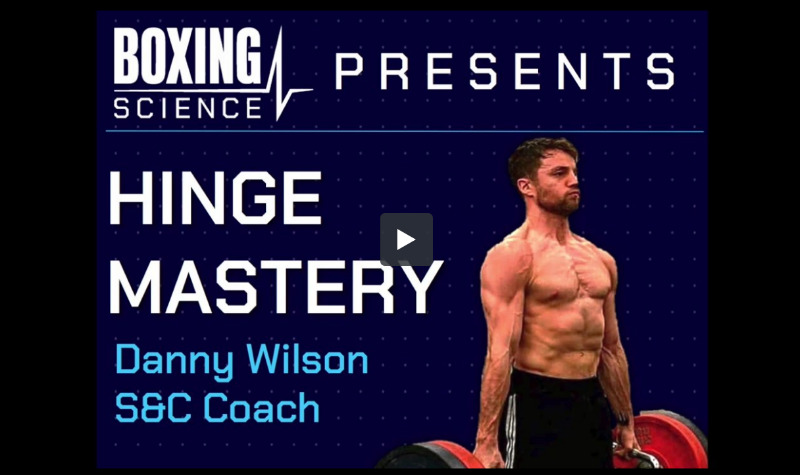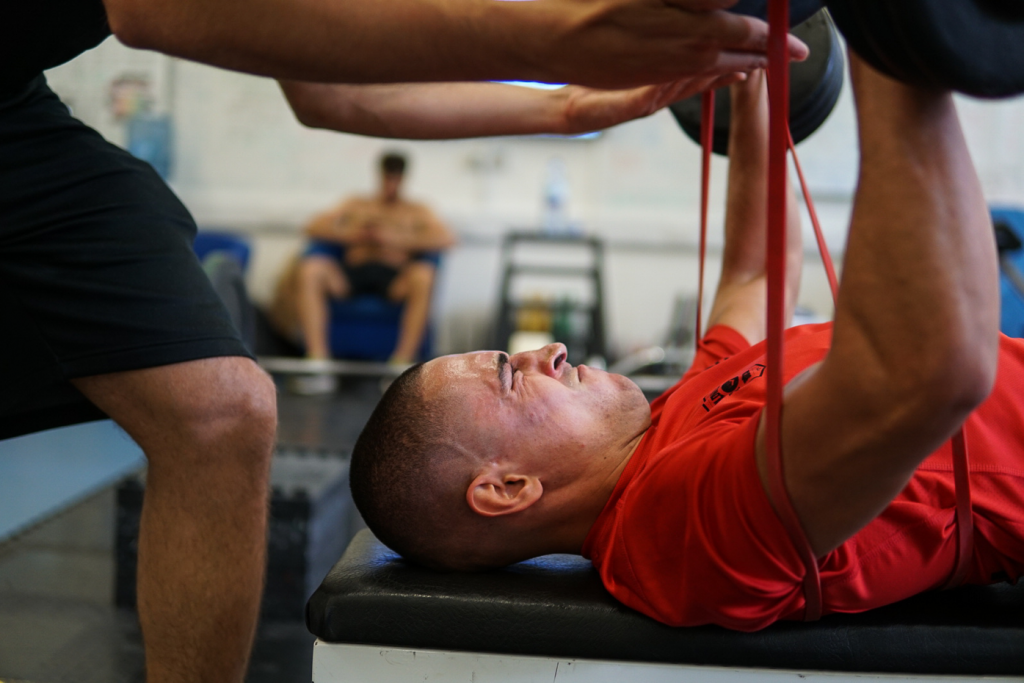Strength Training for Boxing: The Six Pillars
In this article, we’re going to be learning about Strength Training for Boxing and how we structure our programmes using ‘THE SIX PILLARS’
In this article, you will learn.
- Recap of the science behind a forceful punch
- The importance of strength training
- How we divide training into the ‘Six Pillars’
Science Behind The Punch – RECAP
- Punching forces in amateur boxing are around 2500 N… If you weigh 70 kg (11 stone or 154 lbs), you’ll exert about 700 N of force just stood still. That makes punching force about 3.5 times body mass.
- And to make that even more impressive your punch takes around six-hundredths of a second (~60 ms) to throw.
- Punching requires rapid force development and can be developed by explosive strength training. Strength Training for Boxing
Boxing tradition states that adding muscle mass to a boxer will slow them down. Whilst contemporary S&C coaches argue that strength training for boxing is important.
Depending on the training method, however, both are correct.
A forceful punch is dependent on momentum. This is related to how quickly we can move mass towards the target (glove to head).
So the best way to punch harder is to implement strength training for boxing and get bigger, stronger and move faster. That’s why heavyweights with fast hands hit so hard. They generate a lot of force and momentum.
However, boxers are limited to increasing mass because they have to make weight. Therefore, developing momentum without adding excessive muscle mass becomes a priority. This means that a boxer needs to focus on training to develop a neuromuscular system with the capability to generate force rapidly. To achieve this, we use a range of exercises across the force-velocity curve
We have already stated that punching hard relies on producing high amounts of force in very short amount of time. Therefore, a boxer’s priority should be to improve the amount of force that they can produce, and the rate at which they can produce it.
Our strength training methods are simple, effective and evidence-based. In our research; we know that the lean mass of the core and lower-limb force production are important contributors to the punch. We also understand the importance of the upper body, and the limitations caused by functional movement issues of boxers.
This provides the generic training aims of our strength training for boxing and conditioning programs.
You might have seen on our social media some of the advanced training methods we use to help improve a boxers’ strength, speed and explosiveness; including plyometrics, velocity based training and Olympic lifting.
However, all athletes start with the basic S&C methods to improve foundational strength – and this is what we will introduce to you in this e-book.
Our traditional S&C programs include the foundational movements for strength; Squat, Hinge (Deadlift variations), Upper Body Push and Pull, and Single Leg Exercises.
Lower-Body Strength Training For Boxing
Research indicates a punch starts from force development in the lower body.
The lower-body needs to be strong to transfer this energy to the hips, through the core and to the fist to deliver forceful punches. This is what we call the kinetic chain. In our data analysis, we discovered strong relationships between jump height and medicine ball throw distance.
This suggests the higher you can jump, the harder you can punch. The ability to jump is reliant on the amount of impulse produced from the lower body.
This means that lower body strength training can have a huge impact on punch force.
Additionally, the ability to produce force in the lower-body is important to run at high speeds during your conditioning. The faster you can run, the more strain you can put your muscular and cardiovascular system to improve fitness.
PILLAR 1 – THE SQUAT
The squat is an exercise used in many sports and fitness programs because it has multiple benefits. It improves the strength and speed of the lower body, whilst promoting core stability.
The squat, if performed and loaded correctly can improve lower body impulsiveness, hip extension forces and eccentric utilisation of the quads, hamstrings and glutes.
These functions play a huge role in punching and striking force. The squat is also versatile. It can be loaded, light, medium, heavy or fix the bar to train isometric activity of the core which can improve ‘effective mass’ and increasing the snap in your punch
INTRODUCTORY EXERCISE
Goblet Squat is a great way to develop the correct squatting technique without excessively loading the spine.
KEY EXERCISE / END GOAL
The end goal would be the Back Squat as this requires the most RFD, recruit high-threshold motor units and challenge core strength. Front squat could be an option, however many boxers struggle with wrist and shoulder mobility.
LIMITATIONS
The squat is eccentrically demanding, which can make an athlete sore, especially when in a calorie deficit. Also, the back squat technique might be difficult to master due to core weakness, tight hips and imbalances between leg strength.
PILLAR 2 – THE HINGE
The deadlift will develop your posterior chain. This is important to improve the function of your glutes and hamstrings, as well as strengthening your lower back and core. This is important for boxers as the posterior chain isn’t strengthened through traditional boxing training methods.
Although the deadlift has many benefits, you should be cautious when performing deadlifts as a technique can be affected due to limited coaching, understanding or mobility.
Follow our guide, as well as mastering the foundational movements to make sure you get the most out of your deadlifts.
INTRODUCTORY EXERCISE
Romanian Deadlift is a great exercise to develop hip-hinge movement pattern and developing the posterior chain. This is important to develop before moving on to the full deadlift movement.
KEY EXERCISE / END GOAL
The main deadlift exercise we use at Boxing Science is the Trap Bar Deadlift. We prefer this exercise over the straight bar deadlift as the neutral grip is more shoulder-friendly and more elevated from the floor to help reduce forces through the spine. This allows for a better technique which can increase the load, improve strength and reduce the likelihood of injury.
We still coach the conventional deadlift as it is still a desirable movement to master, but when an athlete is ready to increase maximal strength they should opt for Trap Bar Deadlift.
LIMITATIONS
Similar to the points raised regarding the straight bar deadlift, the exercise can be quite hard to master due to lack of postural stability, core strength, tight hamstrings and shoulders.
This limits the amount of intensity and volume that we can put our athletes under. Therefore, we will always programme heavy deadlift exercises for 3-5 reps x 3-5 sets between 60-92% 1RM.
WANT COACHING ON HINGE EXERCISES?
S&C coach and Boxing Science co-founder Danny Wilson takes you through the benefits of these exercises and the key considerations when using them with boxers and combat athletes.
Then in a practical coaching workshop, Danny then takes you through a journey of an athlete first entering the gym using a wide range of exercises to progress towards the main compound lifts. Danny shares useful coaching cues and what to look out for on each exercise so you can get the most out of your strength training.
We have also done this format across different areas of strength training, make sure you check these out so you can execute your programmes with precision.

PILLAR 3 – Uni-Lateral / SINGLE LEG
Successful boxers have strong legs and great balance. However, boxers spend so much time in a split stance that they can have imbalances between leg size and strength, resulting in movement and mobility issues. Unilateral exercises are important for developing both legs in isolation.
INTRODUCTORY EXERCISE
Goblet Split Squat is a great exercise to control the single-leg squatting movement.
KEY EXERCISE / END GOAL
We have various key exercises we would use depending on the current training goals. This could be a Goblet Reverse Lunge, DB Step Up or DB Walking Lunge.
LIMITATIONS
These exercises will be quite difficult to do perform low rep ranges to target strength gains due to stability issues and muscular imbalances.
With this in mind, we use higher volumes of 8-10 repetitions. However, this can end up with an athlete feeling sore the next day so we need to carefully select the exercise and loading. For example, a DB walking lunge is very eccentrically demanding. This could affect our performance if we did these during high-sparring phases.
UPPER-BODY STRENGTH TRAINING FOR BOXING

Your upper body needs to be strong to transfer force through the fist and deal with high impact forces. Despite its importance, you should take care of when training your upper body for two reasons.
1. Poor shoulder mobility can alter technique, causing different activation patterns we don’t particularly want e.g. increased activation of the lower back and anterior deltoids (front of shoulders), which are high-risk injury areas.
2. Unwanted muscle size of the arms and chest could slow down punches due to an increased mass and relatively poor function.
We split the upper-body into two sections. Pushing and Pulling.
In each section, we target Horizontal and Vertical exercises.
PILLAR 4 – PRESSING
Horizontal Press
Press-ups have been performed by many generations of boxers. Pressing exercises can develop the pectorals, deltoids and triceps which are important for producing hand speed and ‘stiffening’ upon impact.
Straight punching requires a horizontal extension of the arms, so the horizontal press seems to have an obvious transfer. However, boxers should take care of technique and progressing these exercises due to shoulder mobility issues.
INTRODUCTORY EXERCISE
Strict Press Ups would be the first exercise we would opt for due to its role of engaging the core and proper scapula retraction. This also requires more action from the triceps, which can be underdeveloped in boxers and combat athletes.
KEY EXERCISE / END GOAL
The main exercise we would find the most strength benefits would be a DB Chest Press.
Formerly we prioritised the Bench Press, however, we found that it was too strenuous for the wrists, elbows and shoulders.
LIMITATIONS
Despite it being less strenuous than using a barbell, the DB chest press can still carry the same risks for wrist, elbow and shoulder pain. Furthermore, many athletes struggle to ‘drive’ through the sticking point when performing heavier loads due to underdeveloped tricep strength.
We often use single-arm, offset and banded variations.
Vertical Press
Boxers have strong shoulders to deliver thudding shots, however, this often results in over-developed anterior deltoids and pectorals. This can cause shoulder tightness and weaknesses in the posterior shoulder.
Sometimes overhead pressing is difficult for boxers. They often compensate by using the lower back or by engaging already-dominant anterior shoulder muscles.
INTRODUCTORY EXERCISE
The first exercise we would use is a landmine shoulder press, as this can recruit the same muscle groups without going overhead. This is an easy exercise to perform and can be loaded quickly, therefore getting a quick win in strength development.
KEY EXERCISE / END GOAL
The ideal exercise to develop vertical pressing would be a DB Push Press. This exercise requires an initial lower-body push to create a transfer of force from lower to the upper body, so can be transferable to boxing performance.
LIMITATIONS
Overhead pressing can become problematic for boxers due to tight shoulders, underactive posterior shoulder muscles and core strength. This can cause super-compensatory patterns such as arching and backward lean, which will increase forces through the lower back.
This can reduce activation of the shoulder muscles, limit the load lifted and increase the likelihood of injury.
PILLAR 5 – PULLING EXERCISES
Horizontal Pull
The reason we use horizontal pulls to develop the back is to develop the different actions of the lats and upper back muscles.
We mentioned earlier that boxers struggle with overhead exercises, meaning activation of the back muscles may be inhibited during vertical pulling exercises.
Horizontal pulling exercises are a useful and effective way to overload the back muscles.
INTRODUCTORY EXERCISE
The first exercise we would use is TRX Row (Suspension Trainer). This is an easy-to-do exercise that can improve strength on the posterior muscles of the upper body.
We often introduce boxers to horizontal pulling exercises with the TRX / Suspension row. This exercise engages the whole body during the pulling action, that can improve postural and core strength.
LIMITATIONS
The horizontal pull has similar limitations to the vertical pull. Athletes should be carefully coached to avoid internal rotation of the humeral head whilst performing horizontal pulling exercises.
Vertical Pull
Pull-ups are a common exercise used when training boxers, but why are these important?
Vertical pulls are an effective way to develop the lats and muscles in the upper back that support the shoulder.
This can help support the shoulder when delivering fast punches. The lats are also important during combination punching to pull back the arm quickly before delivering another punch.
INTRODUCTORY EXERCISE
If an athlete is struggling to perform the required repetitions on neutral grip pull-ups, we would use a band to assist the remaining reps or the complete set.
KEY EXERCISE / END GOAL
The main pulling exercise we use at Boxing Science is a ‘Neutral Grip Pull-Ups’. This exercise can reduce the internal rotation of the humeral head at the top of the movement, therefore creating a more effective scapula retraction, that will increase activation of the lats and posterior shoulder muscles.
LIMITATIONS
Shoulder mobility and postural stability can create problems when performing a pull-up. In particular, this could cause internal rotation of the humeral head. This increases tension on the shoulder tendons and reduces the activation of the target muscle groups.
PILLAR 6 – CORE STRENGTH TRAINING FOR BOXING
Whether it is sit-ups or leg raises, you’ve seen core training in most boxing sessions.
But why do we do it?
Our testing results suggest the stronger your core, the harder your punch! Core strength is important to a forceful punch because it links the lower and upper body in the Kinetic Chain.
The Kinetic Chain is a term used to describe how force is transferred through different parts of the body to produce movement. In punching, force is transferred from the lower-body through to the first.
The core muscles are a vital link between lower- and upper body, and help transfer force during punching actions. Core strength also plays an important role in generating effective mass, this is known as the ‘snap’ of a punch.
Greater ‘snap’ is performed with short, simultaneous activation of many muscle groups, particularly the core, arm and shoulders.
21st Century Core Training
There are four movements of the core, flexion, extension, lateral flexion and rotation.
However, if these movements become excessive the core will crumble and we may cause technique faults or injury. Here are a couple of theoretical examples…
Excessive rotation during combinations could affect the angle of attack or defensive position
Lack of strength decreases stretch-shortening of the core muscles, therefore less punch force produced.
Therefore we need to resist these movements, hence the fundamentals of core training set by American strength coach Mike Robertson.
Here are the four different areas of core training for boxing. We incorporate these exercise types 2-3 times each per week and select different exercises on stability, strength and explosiveness dependant on the training phase.

Summary
Strength training can be very beneficial for Boxing performance when structured appropriately.
This article will help you be able to carefully select exercises to integrate into your training programmes.
If you want help with this, you can join one of our online memberships where we can guide you through ‘The Blueprint to Elite Performance’.
-
 Bespoke Online Strength and Conditioning Program£300.00 £600.00Price range: £300.00 through £600.00
Bespoke Online Strength and Conditioning Program£300.00 £600.00Price range: £300.00 through £600.00 -
 Boxing Science Membership£8.99 / month
Boxing Science Membership£8.99 / month -
 Train Like a Champion£19.99 / month
Train Like a Champion£19.99 / month
